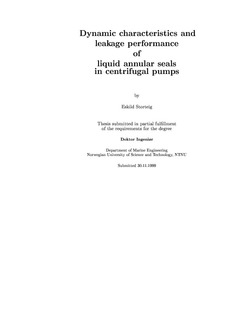| dc.contributor.author | Storteig, Eskild | nb_NO |
| dc.date.accessioned | 2014-12-19T11:24:50Z | |
| dc.date.available | 2014-12-19T11:24:50Z | |
| dc.date.created | 2000-02-24 | nb_NO |
| dc.date.issued | 2000 | nb_NO |
| dc.identifier | 125235 | nb_NO |
| dc.identifier.isbn | 82-7984-020-6 | nb_NO |
| dc.identifier.uri | http://hdl.handle.net/11250/231234 | |
| dc.description.abstract | In centrifugal pumps the leakage and dynamic characteristics of annular seals are important factors for pump performance. Both seal leakage and dynamics are greatly affected by the relationship between fluid flow and wall friction. In this thesis explicit friction factors were developed which relate the turbulent fluid flow in the seal to wall friction for seals with rectangular grooves. Computational Fluid Dynamics (CFD) was used to study a range of groove width to depth ratios between 1 and 16 and groove depth to clearance ratios between 0.2 and 25.8. In this range an optimal groove geometry for leakage reduction was found which may increase the volumetric effciency of pumps considerably. Based on a similarity assumption for grooves and hole patterns a friction factor was proposed for hole pattern seals.
Based on the developed friction factors extensions were made to a theory for predicting dynamic characteristics of plain seals to deal with grooved and hole-patterned seals or a combination of both. The method does not require calibration to experiments in order to give useful results. A parameter study indicated that for certain stator hole patterns the cross-coupled stiffness could be greatly reduced compared to that of a smooth seal. This means that self excited vibrations from the seal may be prevented and the range of stable operation of the pump may be increased. Another extension of the theory accounts for angular stiffness, damping, and added mass moment of inertia for tapered seals. A previously published isotropic friction factor based on pipe flow in the transition between laminar and fully turbulent flow was also invluded in the theory for predicting dynamic coefficients. Results compared well to previously published theoretical results, however, comparisons to experimental results indicate that this friction factor is of limited use for seals.
Inlet and exit conditions of seals affect both seal leakage and rotordynamic coefficients to some extent. An experimental study of inlet and exit losses for seals with sharp, chamfer, and protruding edge inlet and exit geometrics was carried out for a range of axial and tangential flow veloocities. The inlet loss was sensitive to geometry changes, while the exit loss was not. The commonly used assumptions of no rotational speed dependency for entrance and exit losses holds well when the average tangential flow is less than or equal to the axial flow. However, as the tangential flow became much alrger than the axial flow this assumption did not hold well. In the same study leakage for seals with shallow grooves was studied. Experimental leakage results for shallow grooves on the rotor corresponded well with theoretical predictions based on the friction factor developed in this thesis. | nb_NO |
| dc.language | eng | nb_NO |
| dc.publisher | Fakultet for ingeniørvitenskap og teknologi | nb_NO |
| dc.relation.ispartofseries | Dr. ingeniøravhandling, 0809-103X; 2000:1 | nb_NO |
| dc.title | Dynamic characteristics and leakage performance of liquid annular seals in centrifugal pumps | nb_NO |
| dc.type | Doctoral thesis | nb_NO |
| dc.source.pagenumber | 185 | nb_NO |
| dc.contributor.department | Norges teknisk-naturvitenskapelige universitet, Fakultet for ingeniørvitenskap og teknologi | nb_NO |
| dc.description.degree | dr.ing. | nb_NO |
| dc.description.degree | dr.ing. | en_GB |
